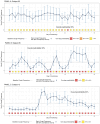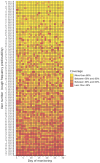Longitudinal Cough Frequency Monitoring in Persistent Coughers: Daily Variability and Predictability
- PMID: 39085518
- PMCID: PMC11427503
- DOI: 10.1007/s00408-024-00734-x
Longitudinal Cough Frequency Monitoring in Persistent Coughers: Daily Variability and Predictability
Abstract
Purpose: We determined the cough counts and their variability in subjects with persistent cough for 30 days.
Methods: The Hyfe cough tracker app uses the mobile phone microphone to monitor sounds and recognizes cough with artificial intelligence-enabled algorithms. We analyzed the daily cough counts including the daily predictability rates of 97 individuals who monitored their coughs over 30 days and had a daily cough rate of at least 5 coughs per hour.
Results: The mean (median) daily cough rates varied from 6.5 to 182 (6.2 to 160) coughs per hour, with standard deviations (interquartile ranges) varying from 0.99 to 124 (1.30 to 207) coughs per hour among all subjects. There was a positive association between cough rate and variability, as subjects with higher mean cough rates (OLS) have larger standard deviations. The accuracy of any given day for predicting all 30 days is the One Day Predictability for that day, defined as the percentage of days when cough frequencies fall within that day's 95% confidence interval. Overall Predictability was the mean of the 30-One Day Predictability percentages and ranged from 95% (best predictability) to 30% (least predictability).
Conclusion: There is substantial within-day and day-to-day variability for each subject with persistent cough recorded over 30 days. If confirmed in future studies, the clinical significance and the impact on the use of cough counts as a primary end-point of cough interventions of this variability need to be assessed.
Keywords: Artificial intelligence; Chronic cough; Cough applications; Cough frequency; Persistent cough.
© 2024. The Author(s).
Conflict of interest statement
KFC has received honoraria for participation on Advisory Board meeting for GSK, AZ, Novartis, Roche, Merck, Trevi, Rickett-Beckinson, Nocion & Shionogi on asthma, COPD and chronic cough. He is on the Scientific Advisory Board of the Clean Breathing Institute supported by Haleon and of Hyfe Inc. He has been renumerated for speaking engagements for GSK, Sanofi, Novartis and AZ. Research grants from GSK and Merck attributed to KFC are received through Imperial College London. LJ, MG, MR and PS are employees of Hyfe, Inc. CCh has received consultancy fees from Hyfe Inc. CCh, MG, MR and PS own equity from Hyfe, Inc. WJS declares grants from Merck Sharp & Dohme Corp. and AstraZeneca, consulting fees from Merck, Bellus, AstraZeneca, Shionogi, and GSK, and lecture fees from Merck, AstraZeneca, GSK, Sanofi, and Novartis.
Figures





References
Publication types
MeSH terms
LinkOut - more resources
Full Text Sources
Medical

